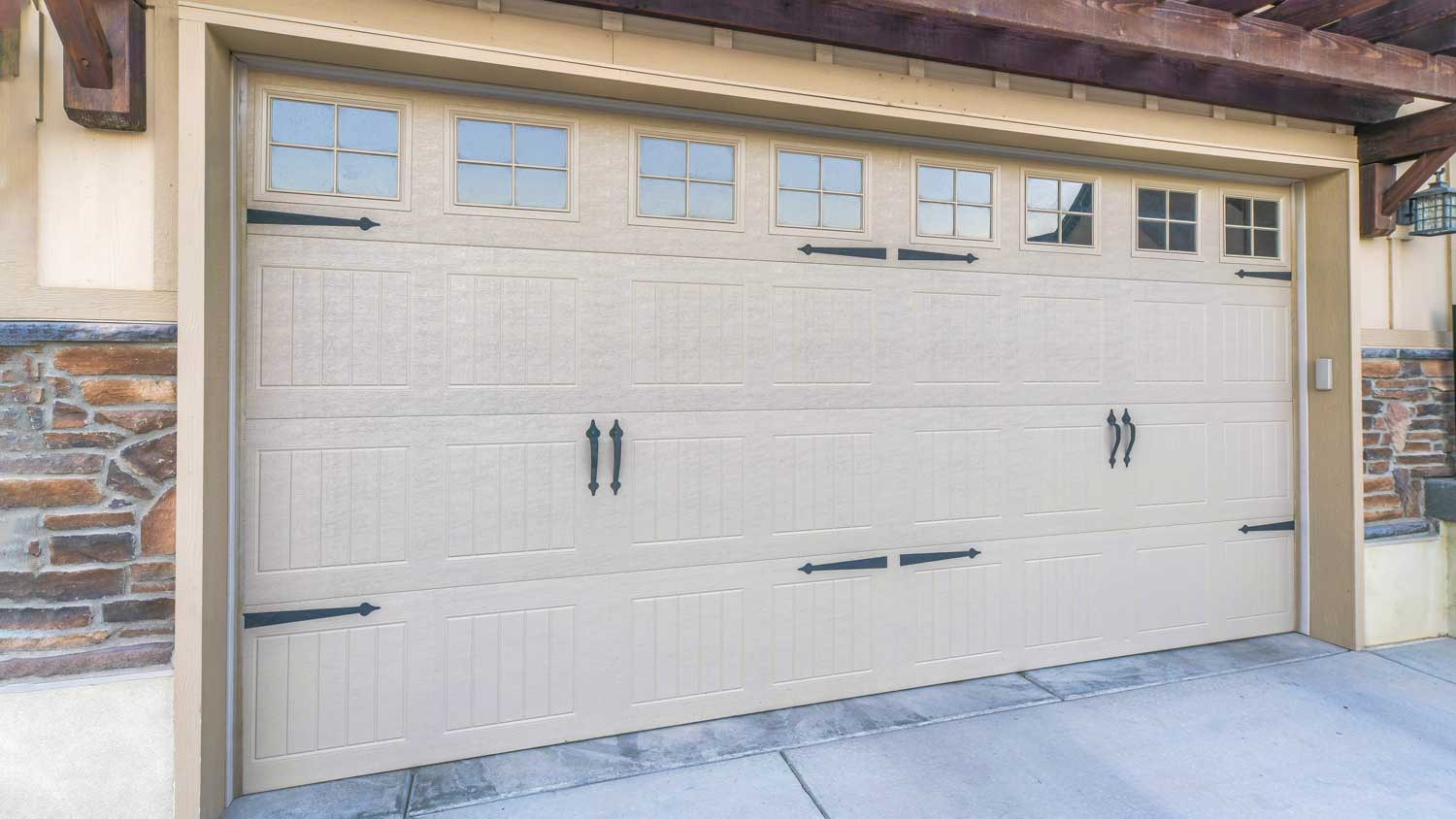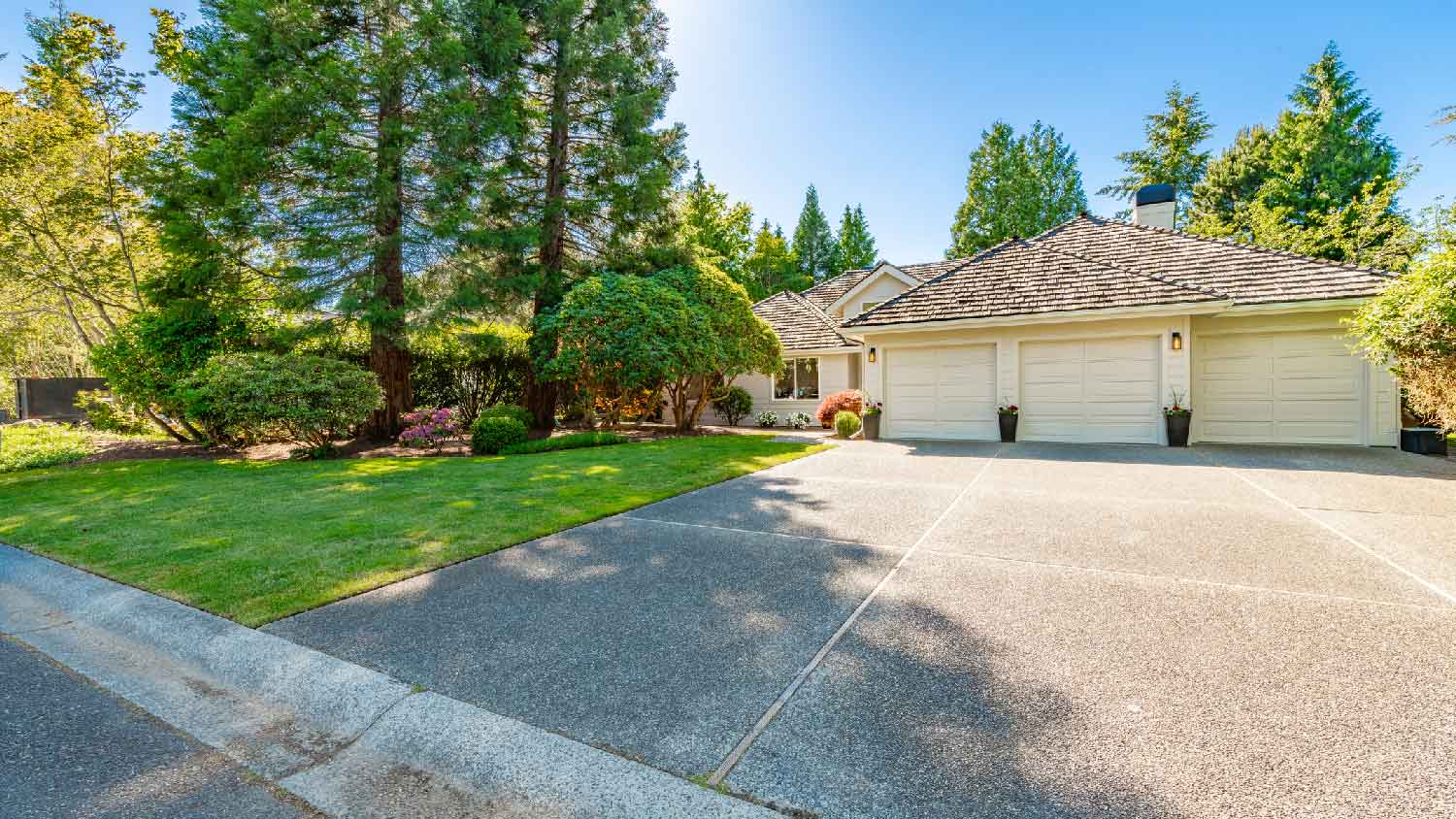11 Essential Tips for Buying a Garage Door
You’ll be the envy of your neighborhood every time you park your car


From potentially boosting your home’s curb appeal to lowering heating and cooling costs, knowing what to look for when buying a garage door is important. For families with small kids, it’s also essential to think about newer safety features as you shop to find the right product for your home and lifestyle.
Here are 11 tips you should consider when buying a new garage door—or replacing an old one.
Where to Buy Garage Doors
When you’re ready to buy a garage door, you have options—starting with your local big-box hardware stores like Home Depot and Lowe’s. You can customize your door online, but these stores are your go-to for something quick and straightforward. If you’re after a more hands-on and interactive experience, head straight to a garage door manufacturer. These companies offer dozens of styles and colors, and some even go the extra mile with digital visualization tools.
Some manufacturers, like Clopay, make it easy to picture your new garage door in your home. You can upload a photo (or use one of their stock images), and you’ll have instant door makeovers to help you visualize how the designs will look. You’ll get to see exactly how different finishes and features work with your overall aesthetic before deciding which one to buy.
Is Buying a Garage Door Worth It?
Yes, buying a new garage door is absolutely worth it. Not only can it last 15-30 years (or more), but in 2024, homeowners saw an incredible 194% return on investment (ROI) for garage door replacements. That means if you’re planning to sell down the road, you could end up making almost double what you spent on the door. Even if you’re not considering selling, a new garage door instantly boosts your curb appeal. It’s a smart investment that pays off in the end.
1. Determine Your Budget for a Garage Door
You might be overwhelmed by the sheer magnitude of garage door options on the market today—or at the variety of prices you’ll find online. That’s why knowing how to buy a garage door that fits your lifestyle—and wallet—is crucial. Before you start shopping, it’s a good idea to set a budget.
“For homeowners with a tight budget, we always recommend starting with a standard, no-frills garage door and opener,” says Bob Tschudi, Expert Review Board member and a Raleigh, North Carolina-based general contractor. “That way, the budget can go towards things that are harder to change or upgrade in the future.”
A new garage door costs between $600 and $3,700, depending on the materials you select. Most manufacturers roll the garage door itself and installation costs into one fee, but be sure to double-check. Generally, the most affordable garage door types are steel, wood, and aluminum, and you’ll pay the most for wood composite, fiberglass, and vinyl.
2. Measure Your Garage Door Opening
While there are standard garage door sizes, that doesn’t necessarily mean your home is fit for one. Standard single-car garage doors measure 8 to 9 feet wide and 7 to 8 feet high. Double-car garage doors will be about 16 feet wide.
Measure the rough opening of your existing garage door to determine which new garage door size you should buy. A rough opening is the framed opening distance, not including any stop molding or trim. Depending on your measurements, you may be able to purchase a standard-sized garage door; otherwise, you’ll need a custom-sized one.
3. Understand Manufacturer Lingo
There are many different components of a garage door, and while knowing technical terms isn’t required, it can certainly help. One easy way to feel more prepared to shop is to understand the three main types of garage doors: single layer, double layer, and premium.
Single layer is made of lightweight steel, fiberglass, and wood
Double layer is more insulated and durable than single layer
Premium is made with high-quality steel and wood with fiberglass sandwiched in between
Premium and double-layer doors cost more but do offer significantly better insulation, which could lower your heating and cooling costs.
Insulation is measured by the R-value. Material between R-6 and R-9 is good for a non-heated garage, but if it’s a living space, you’ll spend a lot more on heating and cooling bills if your R-value is below R-13.
4. Consider Each Type of Garage Door Material
From the classic look of wood to lightweight, durable metal, today’s garage doors are typically made from six different materials, each with a different price tag:
Steel: $650–$3,200
Fiberglass: $800–$2,700
Wood: $900–$4,500
Aluminum: $600–$2,900
Wood Composite: $650–$4,800
Vinyl: $800–$2,500
Steel, fiberglass, and aluminum are some of the most common, while vinyl is a good budget-friendly option. Wood and composite wood can be expensive and may require a special wood garage door installation cost.
If you have your heart set on wooden garage doors, know that you can easily install steel and then use a wood stain to get a similar aesthetic.
Keep in mind that no matter which material you pick, you’ll need to replace the whole garage door—you shouldn’t use an old garage door track with a new garage door.
5. Pick a Garage Door That Matches Your Home’s Style
Your home’s garage door plays a key role in its overall curb appeal. Make sure the one you select matches your home’s color, yard, and overall aesthetic. A sleek garage door will stand out, but a strange style may stick out like a sore thumb.
Many manufacturers use technology so you can see what your new garage door will look like on your home. Use these features, but wait before you buy online.
Keep in mind that you can also paint a garage door to compliment the rest of your home. Painting a garage door costs $1 to $4 per square foot, and can add a whole lot of beauty to your house's exterior.
6. Decide on Garage Door Windows
Most garage door materials give you the option to add windows. Garage windows offer advantages such as natural light. Because they're more expensive, they could also potentially increase your property value.
On the flip side, garage windows may increase heating costs. (Although if your heart is set on one, you could counter this by understanding the different types of garage heaters and installing the right kind for your space.)
For what it’s worth, some home security experts recommend garage doors without windows to detract potential thieves. As an alternative, you might consider installing a garage door screen instead.
“We had a client who wanted the look of windows, but not the security risk that windows provided,” says Tschudi. “We ended up installing a non-windowed steel garage door and then painted black squares where windows would be. You can’t tell that they aren’t windows until you are very close to the garage door.”
7. Consider Garage Door Insulation
Insulated garage door models cost between $200 and $600 more than non-insulated models.
This type of door is especially good for garages with workstations or ones with lofts or additional living spaces above. Basically, if you think you’ll be spending a lot of time in the garage, consider insulation to make it feel more comfortable.
While you’re thinking about long-term investments for this area, you may also consider sealing your garage floors, which could save you from costly garage door repairs down the road.
8. Shop for Garage Door Safety Features
Today, many garage doors come with safety features that protect pets and children. Reverse sensors have been standard on garage doors since the ‘90s. But many new models also offer features like:
Outside motion detection (to ward off potential mischief-makers)
Manual control (in the event of power outages)
Finger-free designs (to prevent little fingers from getting stuck or jammed in the railing)
If you have kids, it’s worth doing research to make sure you’re getting what you need to keep your children safe.
9. Pair Your Garage Door With an Opener
Higher-end garage doors may come with an automatic garage door opener. But more affordable models may not include one, so if you need (or just really want) an opener, it’s a good idea to shop with this in mind to find the best garage door opener. The cost of a new garage opener can be up to $500 after product and installation.
10. Consider Garage Door Security
Garage door openers normally lock the garage door when in the down position, but this mechanism won’t always stop a forceful intruder. Consider incorporating additional garage door security while upgrading your door.
Many homeowners choose to install a smart garage door opener. With this Wi-Fi-connected system, you will be alerted if the garage door is ever opened, and the alert will automatically notify the local authorities.
If your garage door opens manually, you could install a locking handle for extra security. This type of lock attaches to the inside of your garage door frame and must be locked before exiting the inside of the garage.
11. Get an In-Person Quote for Your Garage Door
New technology makes browsing for garage doors online easy. It’s especially useful when you can see what your new potential garage door will look like without ever leaving your house.
However, when it comes time to buy your new garage door, you should get a quote at your actual home. This way, you don’t sign up for a project that doesn’t match your needs or winds up being full of surprises.
Ask a local garage door company for a reasonable quote in your area today.
Frequently Asked Questions
There is no right or wrong answer on how much you should spend on a garage door. For example, if you’re in a colder climate or use your garage as a workshop, investing in an insulated door could save energy costs and comfort. If you’re looking for basic functionality, you could opt for a less expensive, uninsulated option. Just remember—the more bells and whistles (like smart features or custom designs), the higher the price tag. Buy what fits your needs and budget.
The cost to install a garage door is usually around $1,224, with most homeowners seeing a price between $755 and $1,696. Several factors come into play, like the type of door, material (wood is pricier than vinyl), insulation, and size. Labor costs also play a role because DIY garage door installs are a bad—and dangerous—idea. Most professionals bundle labor into the total price, but if it’s separate, expect to pay anywhere from $200 to $500.
When choosing a garage door, start by considering your budget, the weather in your area, and how the door will complement your home’s look. If you’re not sure where to begin, call a local garage door company. They’ll help you figure out what matters, guide you through options, and take care of the installation.





- Garage Door Installation Tips Every Homeowner Should Know
- 50 Stylish Garage Door Ideas
- Convert Garage Door to Entry Door
- 10 Garage Door Maintenance Tips for Maximum Longevity
- Standard Garage Door Sizes and How to Pick the Right One for Your Home
- Can You Install a New Garage Door on Old Tracks?
- Who Do You Hire to Fix or Install a Garage Door?
- What to Do if You Backed Into Your Garage Door
- What Are All the Parts of a Garage Door?
- Types of Garage Doors by Opening Style










